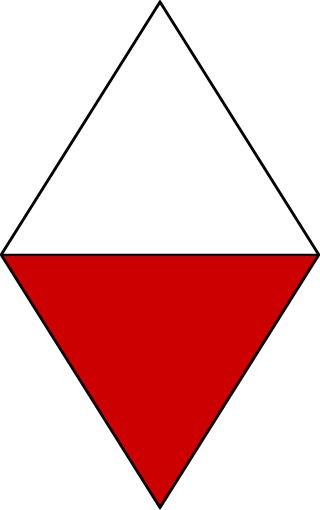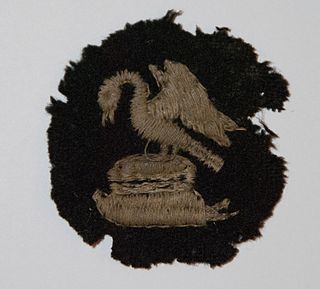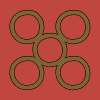
The 11th (Northern) Division, was an infantry division of the British Army during the First World War, raised from men who had volunteered for Lord Kitchener's New Armies. The division fought in the Gallipoli Campaign and on the Western Front. The division's insignia was an ankh or ankhus.

The 42nd Infantry Division was an infantry division of the British Army. The division was raised in 1908 as part of the Territorial Force (TF), originally as the East Lancashire Division, and was redesignated as the 42nd Division on 25 May 1915. It was the first TF division to be sent overseas during the First World War. The division fought at Gallipoli, in the Sinai desert and on the Western Front in France and Belgium. Disbanded after the war, it was reformed in the Territorial Army (TA), in the Second World War it served as the 42nd Infantry Division with the British Expeditionary Force (BEF) and fought in Belgium and France before being evacuated at Dunkirk. The division was later reformed in the United Kingdom and, in November 1941, was converted into the 42nd Armoured Division, which was disbanded in October 1943 without serving overseas. A 2nd Line duplicate formation, the 66th Infantry Division, was created when the Territorials were doubled in both world wars.

The 61st Division was an infantry division of the British Army raised in 1915 during the Great War as a second-line reserve for the first-line battalions of the 48th Division. The division was sent to the Western Front in May 1916 and served there for the duration of the First World War.

The 17th (Northern) Division was an infantry division of the British Army, a Kitchener's Army formation raised during the Great War.

The 8th Infantry Division was an infantry division of the British Army that was active in both the First and Second World Wars. The division was first formed in October 1914 during the First World War, initially consisting mainly of soldiers of the Regular Army and served on the Western Front throughout the war, sustaining many casualties, before disbandment in 1919. The division was reactivated in Palestine, under the command of Major-General Bernard Montgomery, in the late 1930s in the years running up to the Second World War before being disbanded in late February 1940. It was briefly reformed in Syria in an administrative role during 1942-3.

The 34th Division was an infantry division of the British Army that was raised in 1914, during the First World War. The division was raised from volunteers for Lord Kitchener's New Armies, that was originally made up of infantry battalions raised by public subscription or private patronage. The division was taken over by the War Office in September 1915. It served in France and Belgium in the trenches of the Western Front for the duration of the war.

The 21st Division was an infantry division of the British Army during World War I, raised in September 1914 by men volunteering for Lord Kitchener's New Armies. The division moved to France in September 1915 and served on the Western Front for the duration of the First World War. The divisional insignia was the "triple-seven".

The British 30th Division was a New Army division that was originally made up of battalions raised by public subscription or private patronage. The division was taken over by the British War Office in August 1915 and moved to France in December. It served on the Western Front for the duration of the First World War.

The 32nd Division was an infantry division of the British Army that was raised in 1914, during the First World War. The division was raised from volunteers for Lord Kitchener's New Armies, made up of infantry 'Pals battalions' and artillery brigades raised by public subscription or private patronage. The division was taken over by the War Office in September 1915. It served in France and Belgium in the trenches of the Western Front for the duration of the war. It saw action at the Battle of the Somme, the Pursuit to the Hindenburg Line, the Defence of Nieuport, the German spring offensive, and the Allied Hundred Days Offensive beginning at the Battle of Amiens. After the Armistice it marched into Germany as part of the Army of Occupation.
The 22nd Division was an infantry division of the British Army during World War I, raised in September 1914, from men volunteering for Lord Kitchener's New Armies. The division moved to France in September 1915, but it was transferred to Greece only one month later. It served in the Balkans Campaign for the duration of the First World War.

The King's Own Royal Regiment (Lancaster) was a line infantry regiment of the British Army. It served under various titles and fought in many wars and conflicts, including both the First and the Second World Wars, from 1680 to 1959. In 1959, the regiment was amalgamated with the Border Regiment to form the King's Own Royal Border Regiment.

The Loyal Regiment (North Lancashire) (until 1921 known as the Loyal North Lancashire Regiment) was a line infantry regiment of the British Army that was in existence from 1881 to 1970. In 1970, the regiment was amalgamated with the Lancashire Regiment to form the Queen's Lancashire Regiment which was, in 2006, amalgamated with the King's Own Royal Border Regiment and the King's Regiment (Manchester and Liverpool) to form the Duke of Lancaster Regiment (King's, Lancashire and Border).
The 25th Division was an infantry division of the British Army, raised as part of Lord Kitchener's Third New Army (K3) in September 1914, shortly after the outbreak of the Great War. It served on the Western Front for most of the war.

The 37th Division was an infantry division of the British Army, raised during the First World War. The divisional symbol was a gold horseshoe, open end up.

The 59th Division was an infantry division of the British Army during World War I. It was formed in late 1914/early 1915 as a 2nd Line Territorial Force formation raised as a duplicate of the 46th Division. After training in the United Kingdom and saw service in the Easter Rising in April 1916, the division joined the British Expeditionary Force (BEF) on the Western Front in early 1917. It saw action at Ypres and Cambrai, and was almost destroyed during the German Army's Spring Offensive in March 1918. The reconstituted division took part in the final advances of the war.
The 164th Brigade was an infantry brigade of the British Army that saw active service in the First World War as part of the 55th Division. As the 164th Infantry Brigade, it remained in the United Kingdom throughout the Second World War, as part of the 55th Infantry Division.
The 111th Brigade was a formation of the British Army during the First World War. It was raised, under the command of Brigadier-General Reginald Barnes, as part of the new army also known as Kitchener's Army and assigned to the 37th Division. The brigade was also attached to the 34th Division from July to August 1916.
The 226th Infantry Brigade was a Home Service formation of the British Army that existed under various short-lived titles in both World War I and World War II.
73rd Division was a short-lived infantry division of the British Army during World War I. It served in Home Forces and never went overseas.













